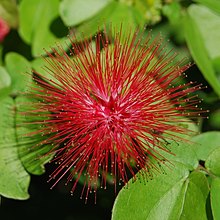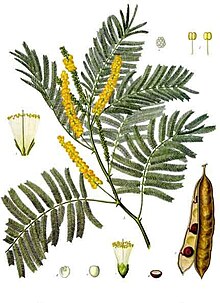Mimosoideae
| Mimosoideae | |
|---|---|

| |
| Calliandra emarginata | |
| Scientific classification | |
| Kingdom: | Plantae |
| Clade: | Tracheophytes |
| Clade: | Angiosperms |
| Clade: | Eudicots |
| Clade: | Rosids |
| Order: | Fabales |
| Family: | Fabaceae |
| Subfamily: | Caesalpinioideae |
| Clade: | Mimosoid clade DC.
|
| Informal groups | |
|
See text | |

| |
| Distribution of the Mimosoideae | |
| Synonyms | |
| |
The Mimosoideae are a traditional subfamily of trees, herbs, lianas, and shrubs in the pea family (Fabaceae) that mostly grow in tropical and subtropical climates. They are typically characterized by having radially symmetric flowers, with petals that are twice divided (valvate) in bud and with numerous showy, prominent stamens.
Recent work on phylogenetic relationships has found that the Mimosoideae form a clade nested with subfamily Caesalpinioideae and the most recent classification by The Legume Phylogeny Working Group refer to them as the Mimosoid clade within subfamily Caesalpinioideae.[1] The group includes about 40 genera and 2,500 species.
Taxonomy
Some classification systems, for example the Cronquist system, treat the Fabaceae in a narrow sense, raising the Mimisoideae to the rank of family as Mimosaceae. The Angiosperm Phylogeny Group treats Fabaceae in the broad sense. The Mimosoideae were historically subdivided into four tribes (Acacieae, Ingeae, Mimoseae, and Mimozygantheae). However, modern molecular phylogenetics has shown that these groupings were artificial. Several informal subgroups have been proposed, but not yet described formally as tribes.[2][3][4][5][6][7] Additionally, the genus Acacia was recently segregated into five genera (Acacia sensu stricto, Acaciella, Mariosousa, Senegalia, and Vachellia).[8][9]
Basal Mimosoideae
- Adenanthera group[10]
- Adenanthera L.
- Amblygonocarpus Harms
- Calpocalyx Harms
- Pseudoprosopis Harms
- Tetrapleura Benth.
- Xylia Benth.
- Entada group[10]
- ElephantorrhizaBenth.
- Entada Adans.
- Piptadeniastrum Brenan
- Newtonia group
- Fillaeopsis Harms
- Indopiptadenia Brenan
- Lemurodendron Villiers & P. Guinet
- Newtonia Baill.
- Prosopis group
- Prosopis L.
- Xerocladia Harv.
- Mimozyganthus group[11]
- Mimozyganthus Burkart
- Piptadeniopsis Burkart
- Prosopidastrum Burkart
- Leucaena group[5][11]
- Desmanthus Willd.
- KanaloaLorence & K.R.Wood
- Leucaena Benth.
- Schleinitzia Warb. ex Nevling & Niezgoda
- Dichrostachys group[5][6][11]
- Alantsilodendron Villiers
- Calliandropsis H.M.Hern. & P.Guinet
- Dichrostachys (DC.) Wight & Arn.
- Gagnebina Neck. ex DC.
- Unassigned
- Aubrevillea Pellegr.
- Chidlowia Hoyle
- Cylicodiscus Harms
- Neptunia Lour
- Pentaclethra Benth.
- Plathymenia Benth.
Acacia clade

- Parkia group
- Anadenanthera Speg.
- Parkia R.Br.
- Piptadenia group[6][12][13]
- Adenopodia C.Presl
- Microlobius C.Presl
- Mimosa L.[14]
- Parapiptadenia Brenan
- Piptadenia Benth.
- Pityrocarpa Britton & Rose
- PseudopiptadeniaRauschert
- Stryphnodendron Mart.
- Abarema group[15][16][17]
- Abarema Pittier
- BaliziaBarneby & J.W.Grimes
- Hydrochorea Barneby & J.W.Grimes
- Ingeae grade (Paraphyletic)
- Acaciella Britton & Rose[18]
- Afrocalliandra E.R. Souza & L.P. Queiroz
- Albizia Durazz.
- Archidendron F.Muell.
- Archidendropsis I.C.Nielsen
- Blanchetiodendron Barneby & J.W.Grimes
- Calliandra Benth.
- Cathormion (Benth.) Hassk.
- Cedrelinga Ducke
- Chloroleucon (Benth.) Britton & Rose
- Cojoba Britton & Rose
- Enterolobium Mart.
- Faidherbia A.Chev.
- Falcataria (I.C.Nielsen) Barneby & J.W.Grimes[19]
- Hesperalbizia Barneby & J.W.Grimes
- Inga Mill.
- Leucochloron Barneby & J.W.Grimes
- Lysiloma Benth.
- Macrosamanea Britton & Rose
- Pararchidendron I.C.Nielsen
- Pseudosamanea Harms
- Samanea (Benth.) Merr.
- Sanjappa E.R. Souza & Krishnaraj[20]
- Serianthes Benth.
- Thailentadopsis Kosterm.
- Viguieranthus Villiers
- Wallaceodendron Koord.
- Zapoteca H.M.Hern.
- Zygia P.Browne
- Pithecellobium group[16][17]
- Ebenopsis Britton & Rose
- Havardia Small
- Painteria Britton & Rose
- Pithecellobium Mart.
- Sphinga Barneby & J.W.Grimes
- Unassigned
- Acacia Mill.
- Mariosousa Seigler & Ebinger
- Paraserianthes I.C.Nielsen
- Parasenegalia Seigler & Ebinger
- Pseudosenegalia Seigler & Ebinger
- Senegalia Raf.
- Vachellia Wight & Arn.
Fossils
The following fossil wood morphogenera have been described:[21][22]
- †Acacioxylon Schenk 1883
- †Adenantheroxylon Prakash & Tripathi 1968
- †Albizinium Prakash 1975
- †Albizzioxylon Nikitin 1935
- †Anadenantheroxylon Brea et al. 2001
- †Cathormion Gros 1990
- †Dichrostachyoxylon Müller-Stoll & Mädel 1967
- †Eucacioxylon Müller-Stoll & Mädel 1967
- †Ingoxylon Müller-Stoll & Mädel 1967
- †Menendoxylon Lutz 1979
- †Metacacioxylon Gros 1981
- †Microlobiusxylon Franco & Brea 2010
- †Mimosoxylon Müller-Stoll & Mädel 1967
- †Mimosaceoxylon Lakhanpal & Prakash1970
- †Paraalbizioxylon Gros 1992
- †Paracacioxylon Müller-Stoll & Mädel 1967
- †Piptadenioxylon Suguio & Mussa 1978
- †Prosopisinoxylon Martínez
- †Tetrapleuroxylon Müller-Stoll & Mädel 1967
Systematics
Modern molecular phylogenetics suggests the following relationships:[23][24][25][26][27][28][29][18]
| ||||||||||||||||||||||||||||||||||||||||||||||||||||||||||||||||||||||||||||||||||||||||||||||||||||||||||||||||
Acacieae

Acacieae (
- Subdivision – 5 or 6 genera
Relationships
In
The only morphological character of Acacieae used to distinguish it from the Ingeae is the presence of free stamens (as in tribe Mimoseae).[32] In the Ingeae they are fused in the form of a tube, whereas in the Acacieae only a few species have the stamens fused at the base. Several characters of the foliage, seeds, seed pods, pollen, and stipules are shared by the two tribes.[32] The flower morphology of Acacia s.l. has characteristics in common with the genera Leucaena, Piptadenia, and Mimosa (tribe Mimoseae) and Enterolobium and Lysiloma (tribe Ingeae).[34]
The tribal position of monotypic genus Faidherbia A. Chevalier is equivocal.[31] It was included in the Acacieae by Vassal (1981) and Maslin et al. (2003), but Lewis & Rico Arce placed it in tribe Ingeae following Polhill (1994) and Luckow et al. (2003).[31][35] In the latter case, tribe Acacieae may conform to genus Acacia s.l., pending the latter's relationship to other mimosoid genera. Faidherbia is troublesome as its stamens are shortly united at their base and its pollen is similar to some taxa in the Ingeae.[33]
Description
They are trees, shrubs or lianas, which may be armed or unarmed.
The inflorescences are dense pedunculate heads or spikes borne in axillary clusters, or are aggregated in terminal panicles.
The ovary is sessile or stipitate (i.e. supported by a stipe), with many ovules or ovules arranged in two rows. The ovary is attached by a filiform style to a small, capitate stigma. The legume's endocarp is attached to the exocarp, but is otherwise very variable, and may be dehiscent or indehiscent. Seeds are usually elliptic to oblong and flattened to varying degrees. Seeds have a hard black-brown testa (i.e. seed coat) with a pleurogram, visible as a closed or almost closed O-shaped line. Some phyllodinous species have a colourful aril or elaiosome on the seed.[36]
References
- doi:10.12705/661.3.
- PMID 20696261.
- S2CID 51898140. Archived from the original(PDF) on 2019-03-24. Retrieved 2017-02-06.
- ISBN 9780855212247.
- ^ ISBN 9781842460177.
- ^ ISBN 9781842460542.
- ISBN 9781842460542.
- JSTOR 27757046.
- .
- ^ S2CID 86054291.
- ^ S2CID 85970875.
- S2CID 85754653.
- S2CID 86335883.
- PMID 19918050.
- S2CID 85889311.
- ^ S2CID 85910836.
- ^ doi:10.12705/626.2.
- ^ S2CID 90369571.
- ^ S2CID 85416700.
- ^ de Souza ER; Krishnara MV; de Queiroz LP (2016). "Sanjappa, a new genus in the tribe Ingeae (Leguminosae: Mimosoideae) from India" (PDF). Rheedea. 26 (1): 1–12.
- .
- hdl:11336/69035.
- doi:10.1043/0363-6445-26.3.487 (inactive 31 January 2024).)
{{cite journal}}: CS1 maint: DOI inactive as of January 2024 (link - JSTOR 25063895.)
{{cite journal}}: CS1 maint: DOI inactive as of January 2024 (link - doi:10.1139/B08-058.
- S2CID 86727446.
- PMID 22699157.
- hdl:10566/3455.
- ^ doi:10.12705/633.2.
- ^ "Taxon: Tribe Acacieae Dumort. (1829) (plant)". The Taxonomicon. Retrieved 19 November 2015.
- ^ a b c d Lewis, G.P. "Acacieae Dumort 1829". Kew. Archived from the original on 6 September 2015. Retrieved 19 November 2015.
- ^ a b c Shinwari, Zabta K.; Jamil, Khansa; Zahra, Nadia Batool (2014). "Molecular systematics of selected genera of subfamily Mimosoideae-Fabaceae" (PDF). Pak. J. Bot. 46 (2): 591–598. Retrieved 23 November 2015.
- ^ PMID 11302857.
- ^ .
- ^ "Taxon: Genus Faidherbia A. Chevalier, 1934 (plant)". The Taxonomicon. Retrieved 19 November 2015.
- ^ a b c 吴德邻, Wu Delin; Nielsen, Ivan C. (2009). "Flora of China, 6. Tribe ACACIEAE" (PDF). Missouri Botanical Garden Press. Retrieved 19 November 2015.
- ^ a b Armstrong, W. P. "Botany 115 Vegetative Terminology, Modified Roots, Stems and Leaves". Waynes Word. Retrieved 19 November 2015.
- ^ a b c "Acacia, Thorntree". EOL. Retrieved 22 November 2015.
- ISBN 9780521452571.
External links
 Data related to Acacieae at Wikispecies
Data related to Acacieae at Wikispecies Media related to Mimosoideae at Wikimedia Commons
Media related to Mimosoideae at Wikimedia Commons
